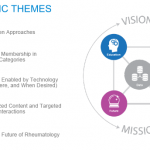 ACR CONVERGENCE 2020—In her ARP keynote address on Friday, Nov. 6, Empowering Patients to Make an Impact on the Future of Healthcare, Jen Horonjeff, PhD, described a study in which researchers gathered data on pain and activity level among arthritis patients. In her view, the study provided a cautionary tale.
ACR CONVERGENCE 2020—In her ARP keynote address on Friday, Nov. 6, Empowering Patients to Make an Impact on the Future of Healthcare, Jen Horonjeff, PhD, described a study in which researchers gathered data on pain and activity level among arthritis patients. In her view, the study provided a cautionary tale.
Researchers expected the study subjects would be more physically active, as recorded on wearable devices, as their pain levels dropped. But for one patient, as her reported pain levels dropped, her activity level did not increase.
They found out why when they talked to the patient: She was a writer, and being pain-free allowed her to spend time writing—a sedentary activity.
Dr. Horonjeff—founder and CEO of the Savvy Cooperative, a patient-owned organization designed to improve patient input into medical research and innovation—said this study offers a stark illustration of how the expectations and goals of scientists and researchers can differ from those of patients.
To help healthcare professionals better meet patient needs, Dr. Horonjeff offered nine lessons.
Lesson 1: Arthritis Can Be a Lonely Place
As a juvenile arthritis patient herself, Dr. Horonjeff said she can’t remember a time when she did not have an arthritis diagnosis. She said she always felt like an outsider. Doctors, teachers and others (except her parents) routinely made assumptions about what she was capable of and set limits for her. She didn’t meet another person with arthritis until she was a teenager.
Lesson 2: Have Cool Stuff
Health professionals shouldn’t underestimate the value of little things to make the patient experience special at doctor visits. To this day, she remembers a porcelain bird mobile she would look at as a child during appointments. She also remembers little plastic, jumping-insect toys and Snoopy Band-Aids.
Lesson 3: More Than 1 Person Is Affected by Arthritis
The patient, their immediate family and caregivers are all affected by rheumatic disease, and care plans must keep in mind the effects on caregivers and family. “Different personalities need to be dealt with in a really deliberate way,” Dr. Horonjeff said.
Lesson 4: Don’t Forget the Patient Priorities
Too often, she said, clinical trials are designed and conducted without input from patients on what they would like to see achieved to make their daily lives better. For example, an oral therapeutic, rather than infusion therapy, may make dramatic differences to certain patients—perhaps they’re studying abroad or have a fear of needles, she said. “If we don’t stop and do the work to understand what matters to patients early on, we don’t actually know when [a therapy] comes to market if it’s solving the problems patients want [solved],” she said.


